Spatio-Temporal Variation of Habitat Quality for Bird Species in China Caused by Land Use Change during 1995–2015
Abstract
:1. Introduction
2. Study Area and Data Source
3. Methodology
4. Results and Analysis
4.1. Land Use Change in 1995–2015
4.2. Quantitative Changes of Bird Habitat Suitability
4.3. The Spatial Distribution of Suitability for Bird Habitats
5. Discussion
5.1. The Relationship between the Intensity of LUC and PGSH
5.2. Influence of Two Land Use Policies on PGSH
6. Conclusions
Author Contributions
Funding
Informed Consent Statement
Data Availability Statement
Conflicts of Interest
References
- Lambin, E.F.; Meyfroidt, P. Global LUC, economic globalization, and the looming land scarcity. Proc. Natl. Acad. Sci. USA 2011, 108, 3465–3472. [Google Scholar] [CrossRef]
- Rosenberg, K.V.; Dokter, A.M.; Blancher, P.J.; Sauer, J.R.; Smith, A.C.; Smith, P.A.; Marra, P.P. Decline of the North American avifauna. Science 2019, 366, 120–124. [Google Scholar] [CrossRef] [PubMed]
- Sterling, S.M.; Ducharne, A.; Polcher, J. The impact of global land-cover change on the terrestrial water cycle. Nat. Clim. Chang. 2013, 3, 385. [Google Scholar] [CrossRef]
- Wu, H.; Lin, A.; Xing, X.; Song, D.; Li, Y. Identifying core driving factors of urban land use change from global land cover products and POI data using the random forest method. Int. J. Appl. Earth Obs. Geoinf. 2021, 103, 102475. [Google Scholar] [CrossRef]
- Liu, Y.; He, Q.; Tan, R.; Liu, Y.; Yin, C. Modeling different urban growth patterns based on the evolution of urban form: A case study from Huangpi, central China. Appl. Geogr. 2016, 66, 109–118. [Google Scholar] [CrossRef]
- Pielke Sr, R.A. Land use and climate change. Science 2005, 310, 1625–1626. [Google Scholar] [CrossRef] [PubMed]
- Zhang, D.; Liu, X.; Wu, X.; Yao, Y.; Wu, X.; Chen, Y. Multiple intra-urban land use simulations and driving factors analysis: A case study in Huicheng, China. GISci. Remote Sens. 2019, 56, 282–308. [Google Scholar] [CrossRef]
- Du, X.; Jin, X.; Yang, X.; Yang, X.; Zhou, Y. Spatial pattern of land use change and its driving force in Jiangsu Province. Int. J. Environ. Res. Public Health 2014, 11, 3215–3232. [Google Scholar] [CrossRef] [PubMed]
- Sala, O.E.; Stuart Chapin, F.I.I.I.; Armesto, J.J.; Berlow, E.; Bloomfield, J.; Dirzo, R.; Huber-Sanwald, E.; Huenneke, L.F.; Wall, D.H. Global biodiversity scenarios for the year 2100. Science 2000, 287, 1770–1774. [Google Scholar] [CrossRef] [PubMed]
- Northrup, J.M.; Rivers, J.W.; Yang, Z.; Betts, M.G. Synergistic effects of climate and land-use change influence broad-scale avian population declines. Glob. Chang. Biol. 2019, 25, 1561–1575. [Google Scholar] [CrossRef] [PubMed]
- Powers, R.P.; Jetz, W. Global habitat loss and extinction risk of terrestrial vertebrates under future land-use-change scenarios. Nat. Clim. Chang. 2019, 9, 323. [Google Scholar] [CrossRef]
- Mistry, J.; Berardi, A.; Simpson, M. Birds as indicators of wetland status and change in the North Rupununi, Guyana. Biodivers. Conserv. 2008, 17, 2383–2409. [Google Scholar] [CrossRef]
- Ali, A.A.; Idris, N.H.; Ishak, M.H.I. The influence of land use land cover changes on urban bird communities. Int. Arch. Photogramm. Remote Sens. Spat. Inf. Sci. 2019. [Google Scholar] [CrossRef]
- Regos, A.; Imbeau, L.; Desrochers, M.; Leduc, A.; Robert, M.; Jobin, B.; Brotons, L.; Drapeau, P. Hindcasting the impacts of land-use changes on bird communities with species distribution models of Bird Atlas data. Ecol. Appl. 2018, 28, 1867–1883. [Google Scholar] [CrossRef]
- Scholtz, R.; Polo, J.A.; Fuhlendorf, S.D.; Duckworth, G.D. Land cover dynamics influence distribution of breeding birds in the Great Plains, USA. Biol. Conserv. 2017, 209, 323–331. [Google Scholar] [CrossRef]
- Newbold, T.; Scharlemann, J.P.; Butchart, S.H.; Şekercioğlu, Ç.H.; Alkemade, R.; Booth, H.; Purves, D.W. Ecological traits affect the response of tropical forest bird species to land-use intensity. Proc. R. Soc. B Biol. Sci. 2013, 280, 20122131. [Google Scholar] [CrossRef]
- Sohl, T.L. The relative impacts of climate and land-use change on conterminous United States bird species from 2001 to 2075. PLoS ONE 2014, 9, e112251. [Google Scholar]
- Chiawo, D.O.; Kombe, W.N.; Craig, A.J. Bird responses to LUC: Guild diversity in a Kenyan coastal forest and adjoining habitats. Emu-Austral Ornithol. 2018, 118, 281–292. [Google Scholar] [CrossRef]
- Chapman, P.M.; Tobias, J.A.; Edwards, D.P.; Davies, R.G. Contrasting impacts of land-use change on phylogenetic and functional diversity of tropical forest birds. J. Appl. Ecol. 2018, 55, 1604–1614. [Google Scholar] [CrossRef]
- Waltert, M.; Mardiastuti, A.; Mühlenberg, M. Effects of land use on bird species richness in Sulawesi, Indonesia. Conserv. Biol. 2004, 18, 1339–1346. [Google Scholar] [CrossRef]
- Okada, S.; Lindenmayer, D.B.; Wood, J.T. Does LUC influence predation of bird nests? Austral Ecol. 2019, 44, 768–776. [Google Scholar] [CrossRef]
- Zhang, Y.; Wang, H.; Xie, P.; Rao, Y.; He, Q. Revisiting spatiotemporal changes in global urban expansion during 1995 to 2015. Complexity 2020, 2020, 6139158. [Google Scholar] [CrossRef]
- Wang, C.; He, J.; Liu, D.; Yu, X.; Shi, Q. Impact of land use change on bird habitat connectivity: A case study in Ezhou City. Acta Ecol. Sin. 2022, 42, 4197–4208, (In Chinese with English Abstract). [Google Scholar]
- Cintra, R.; Magnusson, W.E.; Albernaz, A. Spatial and temporal changes in bird assemblages in forest fragments in an eastern Amazonian savannah. Ecol. Evol. 2013, 3, 3249–3262. [Google Scholar] [CrossRef]
- Crooks, K.R. Relative sensitivities of mammalian carnivores to habitat fragmentation. Conserv. Biol. 2002, 16, 488–502. [Google Scholar] [CrossRef]
- Fahrig, L. Effects of habitat fragmentation on biodiversity. Annu. Rev. Ecol. Evol. Syst. 2003, 34, 487–515. [Google Scholar] [CrossRef]
- Zhang, Z.; Zheng, M. Advances in the Study of Bird Habitat Selection; China Forestry Press: Beijing, China, 1999. [Google Scholar]
- Ministry of Environmental Protection, the People’s Republic of China. China Biodiversity Red List. 2015. Available online: http://www.mee.gov.cn/gzfw/spk/hbbvideo/Videos/201605/t20160531_352442.shtml (accessed on 1 July 2020).
- Liu, L.; Liu, H.Y.; Li, Y.F.; Wang, J.; Xie, F.F. Dynamic changes in population size and habitat distribution of wintering red-crowned crane in northern Jiangsu Province. Acta Ecol. Sin. 2018, 38, 926–933, (In Chinese with English Abstract). [Google Scholar]
- Xu, Y.; Lin, S.; He, J.; Xin, Y.; Zhang, L.; Jiang, H.; Li, Y. Tropical birds are declining in the Hainan Island of China. Biol. Conserv. 2017, 210, 9–18. [Google Scholar] [CrossRef]
- Fang, W.Z.; Chen, Z.H.; Chen, X.L.; Lin, Q.X. Avian community diversity during winter in Xiamen wetlands. Mar. Sci. 2007, 31, 10–16, (In Chinese with English Abstract). [Google Scholar]
- Jiang, Z.; Ma, K. Status quo, challenges and strategy in conservation biology. Biodivers. Sci. 2009, 17, 107–116. [Google Scholar]
- Dai, S.; Feng, D.; Chan, K.; Gong, P.; Xu, B. A spatialized digital database for all bird species in China. Sci. China Life Sci. 2019, 62, 661–667. [Google Scholar] [CrossRef]
- He, F.Q.; Fellowes, J.R.; Chan, B.P.; Lau, M.W.; Lin, J.S.; Shing, L.K. An update on the distribution of the ‘Endangered’ White-eared Night Heron Gorsachius magnificus in China. Bird Conserv. Int. 2007, 17, 93–101. [Google Scholar] [CrossRef]
- Chen, J.; Zhang, B.; Ma, K.; Jiang, Z. Bibliometric analysis of status quo of conservation biology in China. Biodivers. Sci. 2009, 17, 423–429. [Google Scholar]
- Si, Y.; Xin, Q.; Prins, H.H.; De Boer, W.F.; Gong, P. Improving the quantification of waterfowl migration with remote sensing and bird tracking. Sci. Bull. 2015, 60, 1984–1993. [Google Scholar] [CrossRef]
- Bonney, R.; Cooper, C.B.; Dickinson, J.; Kelling, S.; Phillips, T.; Rosenberg, K.V.; Shirk, J. Citizen science: A developing tool for expanding science knowledge and scientific literacy. BioScience 2009, 59, 977–984. [Google Scholar] [CrossRef]
- Supp, S.R.; Sorte, F.A.L.; Cormier, T.A.; Lim, M.C.; Powers, D.R.; Wethington, S.M.; Graham, C.H. Citizen-science data provides new insight into annual and seasonal variation in migration patterns. Ecosphere 2015, 6, 1–19. [Google Scholar] [CrossRef]
- Li, X.; Liang, L.; Gong, P.; Liu, Y.; Liang, F. Bird watching in China reveals bird distribution changes. Chin. Sci. Bull. 2013, 58, 649–656. [Google Scholar] [CrossRef]
- Sullivan, B.L.; Wood, C.L.; Iliff, M.J.; Bonney, R.E.; Fink, D.; Kelling, S. eBird: A citizen-based bird observation network in the biological sciences. Biol. Conserv. 2009, 142, 2282–2292. [Google Scholar] [CrossRef]
- EBird Basic Dataset (EBD). Version: EBD_relApr-2019; Cornell Lab of Ornithology: Ithaca, NY, USA, 2019. [Google Scholar]
- He, Q.; Song, Y.; Liu, Y.; Yin, C. Diffusion or coalescence? Urban growth pattern and change in 363 Chinese cities from 1995 to 2015. Sustain. Cities Soc. 2017, 35, 729–739. [Google Scholar] [CrossRef]
- Lai, L.; Huang, X.; Yang, H.; Chuai, X.; Zhang, M.; Zhong, T.; Chen, Z.; Chen, Y.; Wang, X.; Thompson, J.R. Carbon emissions from land-use change and management in China between 1990 and 2010. Sci. Adv. 2016, 2, e1601063. [Google Scholar] [CrossRef]
- Thiessen, A.H. Precipitation averages for large areas. Mon. Weather. Rev. 1911, 39, 1082–1089. [Google Scholar] [CrossRef]
- Fu, W.; Jiang, P.; Zhou, G.; Zhao, K. Using Moran’s I and GIS to study the spatial pattern of forest litter carbon density in a subtropical region of southeastern China. Biogeosciences 2014, 11, 2401–2409. [Google Scholar] [CrossRef]
- Anselin, L. Local indicators of spatial association—LISA. Geogr. Anal. 1995, 27, 93–115. [Google Scholar] [CrossRef]
- Bennett, J. Event causation: The counterfactual analysis. Philos. Perspect. 1987, 1, 367–386. [Google Scholar] [CrossRef]
- Butler, S.; Boccaccio, L.; Gregory, R.; Vorisek, P.; Norris, K. Quantifying the impact of land-use change to European farmland bird populations. Agric. Ecosyst. Environ. 2010, 137, 348–357. [Google Scholar] [CrossRef]
- De Lima, R.F.; Dallimer, M.; Atkinson, P.; Barlow, J. Biodiversity and land-use change: Understanding the complex responses of an endemic-rich bird assemblage. Divers. Distrib. 2013, 19, 411–422. [Google Scholar] [CrossRef]
- Acevedo, M.; Restrepo, C. Land-cover and land-use change and its contribution to the large-scale organization of Puerto Rico’s bird assemblages. Divers. Distrib. 2008, 14, 114–122. [Google Scholar] [CrossRef]
- Dinda, S. Environmental Kuznets curve hypothesis: A survey. Ecol. Econ. 2004, 49, 431–455. [Google Scholar] [CrossRef]
- Trac, C.; Schmidt, A.; Harrell, S.; Hinckley, T. Environmental reviews and case studies: Is the returning farmland to forest program a success? Three case studies from Sichuan. Environ. Pract. 2013, 15, 350–366. [Google Scholar] [CrossRef]
- Li, Z.; Sun, X.; Huang, Z.; Zhang, X.; Wang, Z.; Li, S.; Zhai, B. Changes in nutrient balance, environmental effects, and green development after returning farmland to forests: A case study in Ningxia, China. Sci. Total Environ. 2020, 735, 139370. [Google Scholar] [CrossRef]
- Mu, H.; Li, X.; Ma, H.; Du, X.; Huang, J.; Su, W.; Li, B. Evaluation of the policy-driven ecological network in the Three-North Shelterbelt region of China. Landsc. Urban Plan. 2022, 218, 104305. [Google Scholar] [CrossRef]
- Wang, H.; He, M.; Ran, N.; Xie, D.; Wang, Q.; Teng, M.; Wang, P. China’s key forestry ecological development programs: Implementation, environmental impact and challenges. Forests 2021, 12, 101. [Google Scholar] [CrossRef]
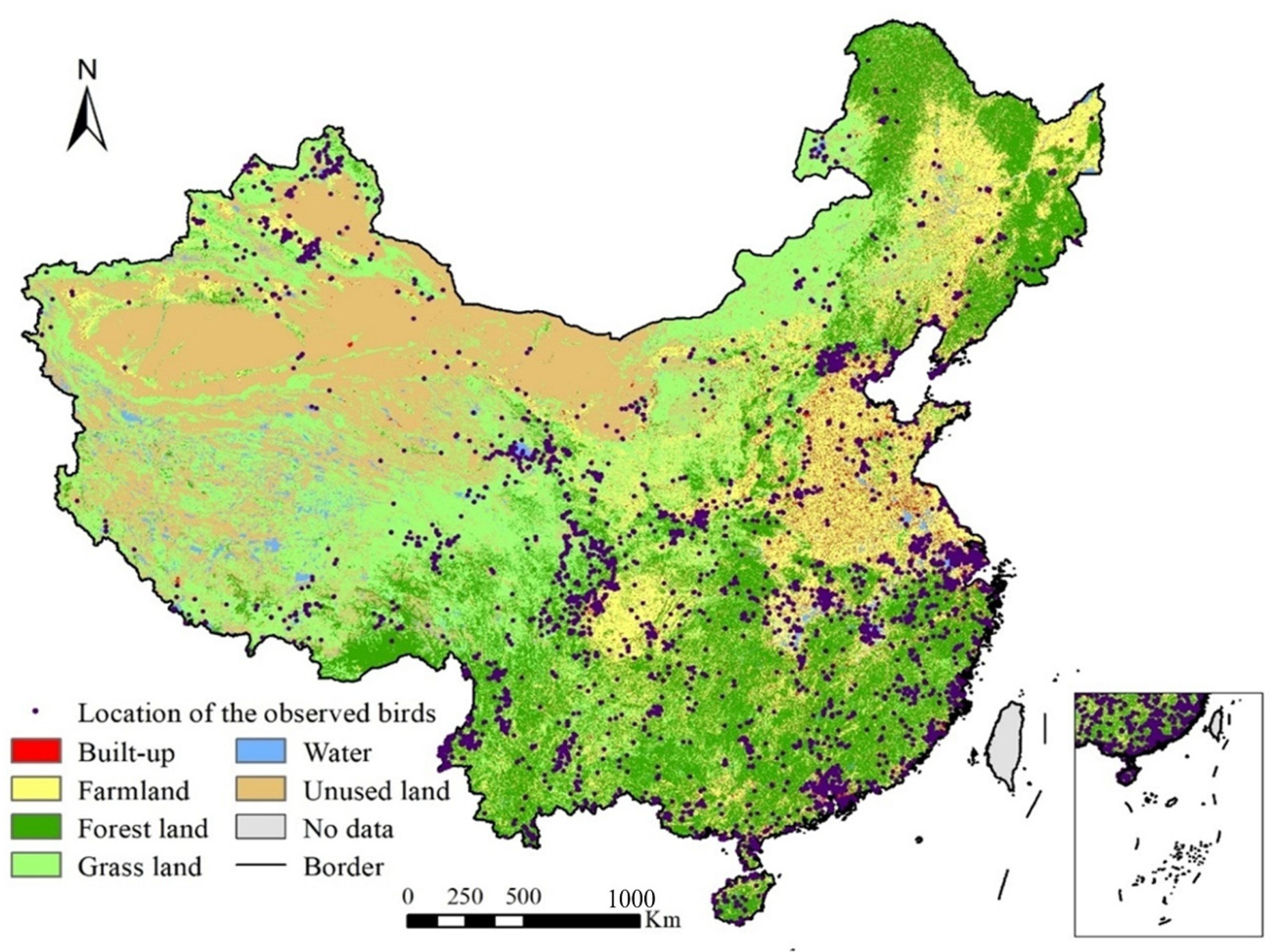
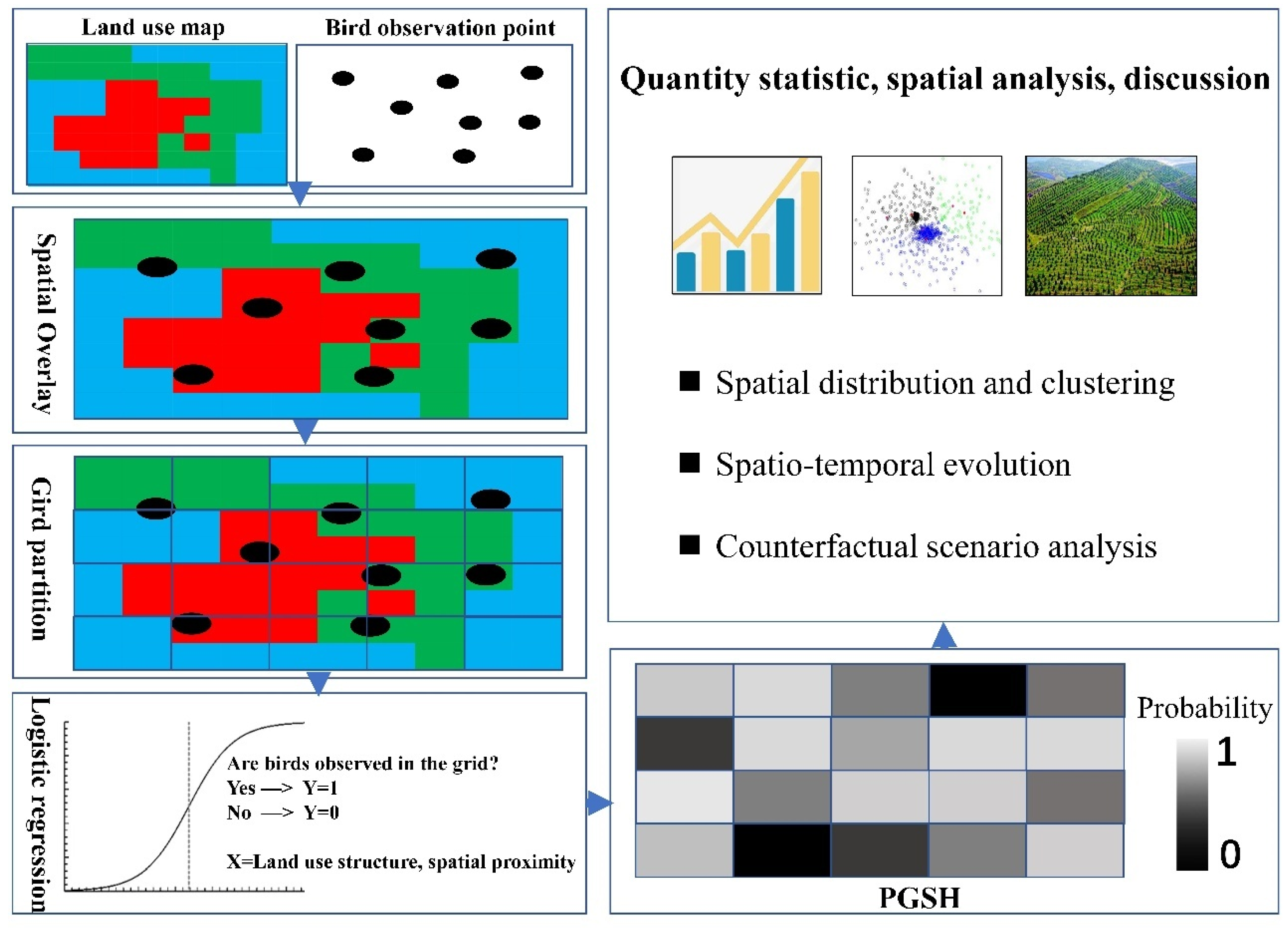
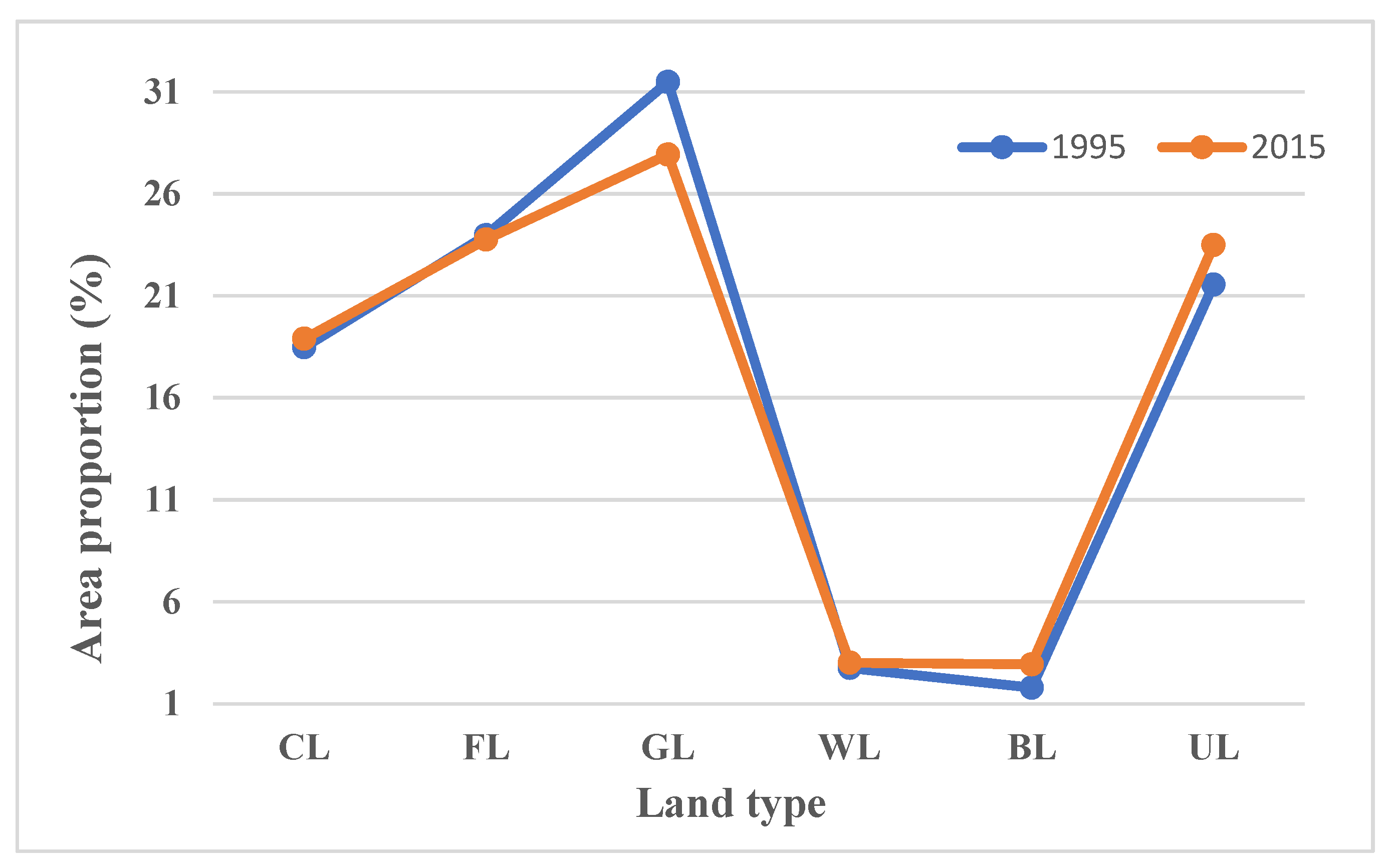

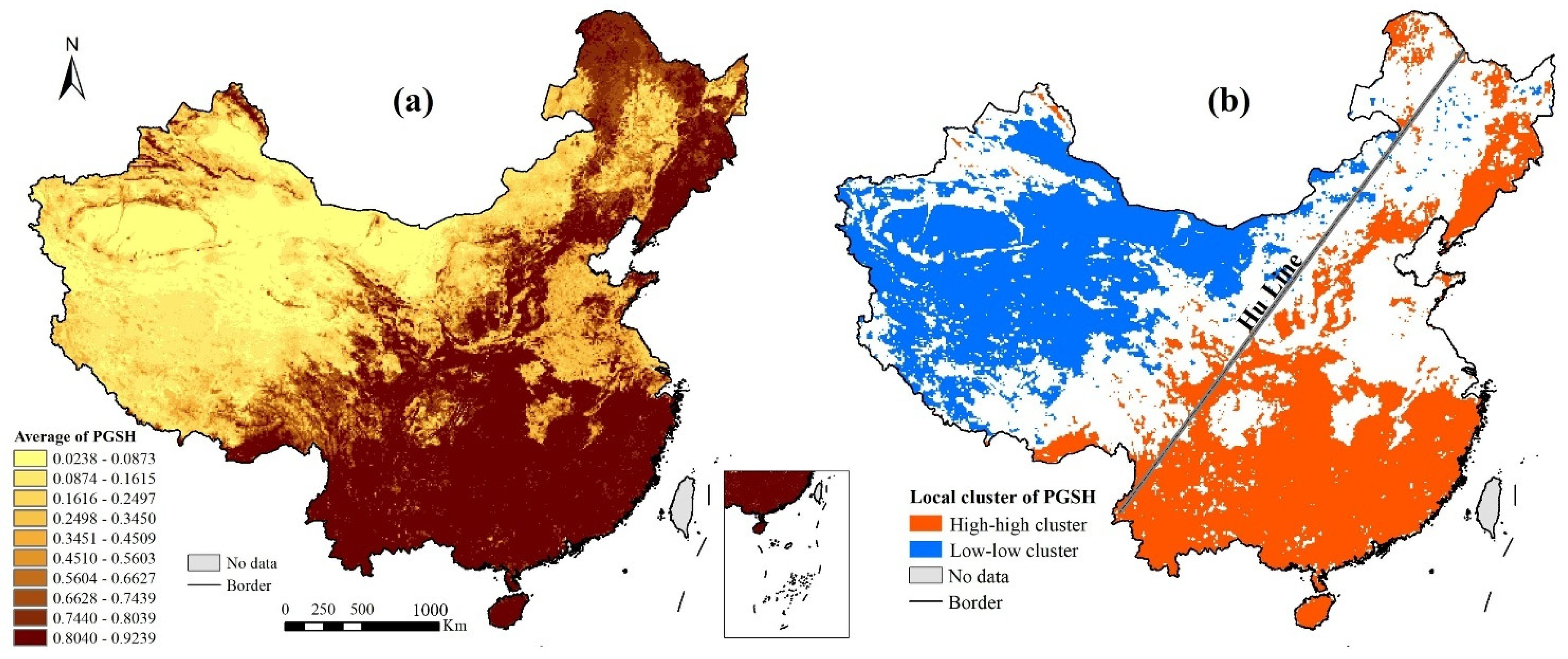
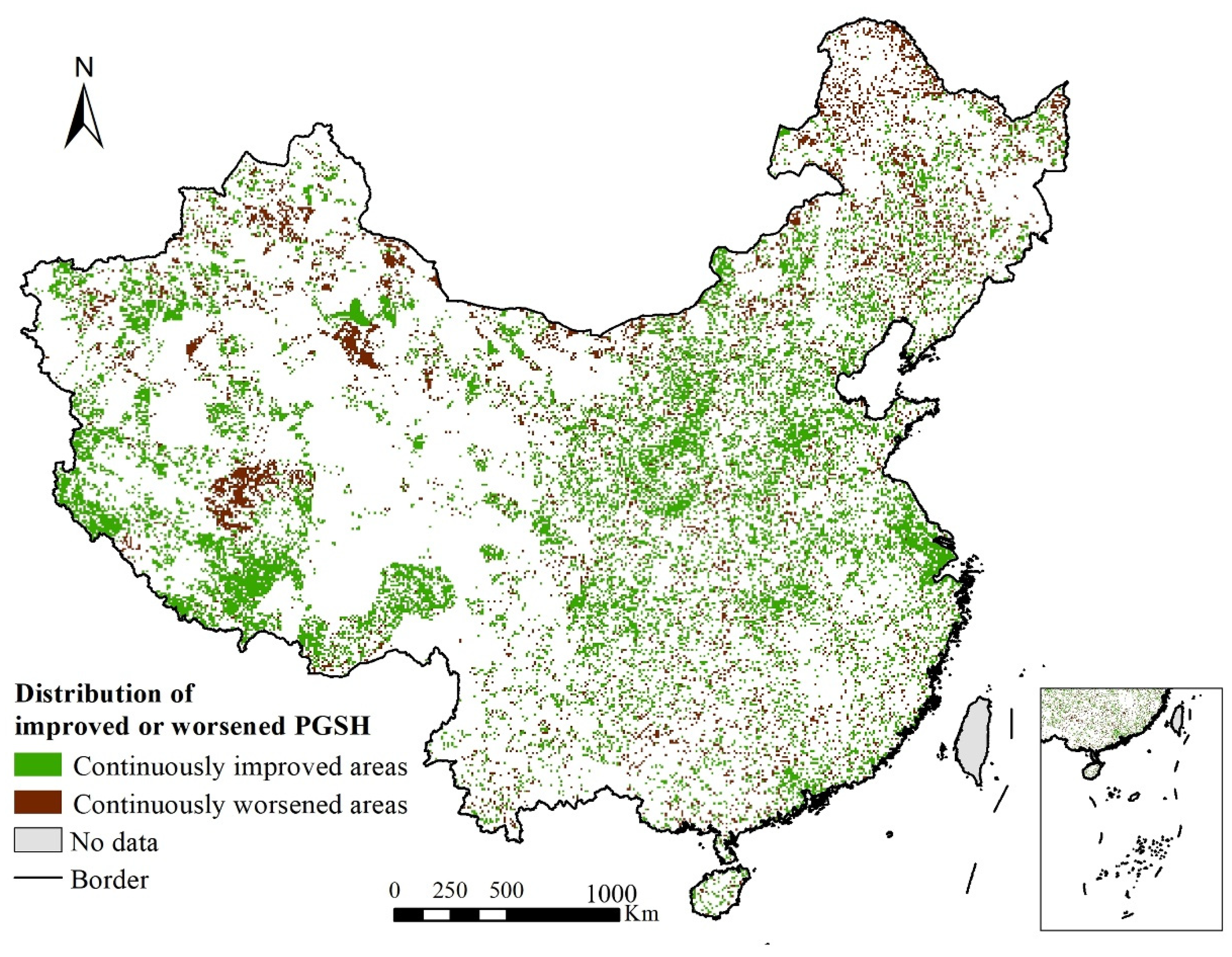
| Land Use Type | CL | FL | GL | WL | BL | UL |
|---|---|---|---|---|---|---|
| CL | 1,543,309.64 | 56,402.96 | 55,947.74 | 18,442.05 | 88,532.43 | 10,224.89 |
| FL | 86,234.84 | 2,016,160.76 | 125,749.32 | 8406.80 | 33,374.31 | 30,836.77 |
| GL | 111,111.40 | 176,691.31 | 2,151,035.08 | 43,172.08 | 13,472.24 | 527,014.15 |
| WL | 12,957.20 | 4594.05 | 20,414.69 | 180,167.35 | 4207.66 | 41,929.24 |
| BL | 25,952.83 | 2084.32 | 2254.03 | 4406.07 | 136,487.09 | 942.86 |
| UL | 33,822.70 | 24,570.33 | 324,941.50 | 34,439.86 | 5527.71 | 1,644,181.76 |
| Variable | Coefficient |
|---|---|
| LandCR | 0.082 *** |
| LandCR2 | −0.061 *** |
Publisher’s Note: MDPI stays neutral with regard to jurisdictional claims in published maps and institutional affiliations. |
© 2022 by the authors. Licensee MDPI, Basel, Switzerland. This article is an open access article distributed under the terms and conditions of the Creative Commons Attribution (CC BY) license (https://creativecommons.org/licenses/by/4.0/).
Share and Cite
Qiu, B.; Yao, J.; Han, S.; Zhu, Z. Spatio-Temporal Variation of Habitat Quality for Bird Species in China Caused by Land Use Change during 1995–2015. Sustainability 2022, 14, 10078. https://doi.org/10.3390/su141610078
Qiu B, Yao J, Han S, Zhu Z. Spatio-Temporal Variation of Habitat Quality for Bird Species in China Caused by Land Use Change during 1995–2015. Sustainability. 2022; 14(16):10078. https://doi.org/10.3390/su141610078
Chicago/Turabian StyleQiu, Bingkui, Jinjiang Yao, Siyu Han, and Zhe Zhu. 2022. "Spatio-Temporal Variation of Habitat Quality for Bird Species in China Caused by Land Use Change during 1995–2015" Sustainability 14, no. 16: 10078. https://doi.org/10.3390/su141610078
APA StyleQiu, B., Yao, J., Han, S., & Zhu, Z. (2022). Spatio-Temporal Variation of Habitat Quality for Bird Species in China Caused by Land Use Change during 1995–2015. Sustainability, 14(16), 10078. https://doi.org/10.3390/su141610078





